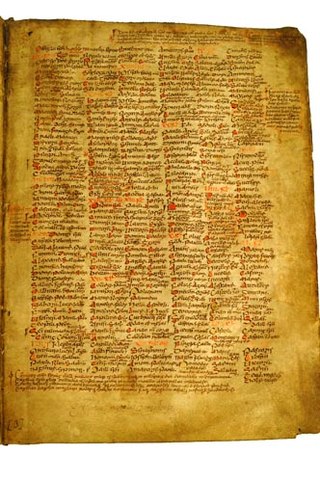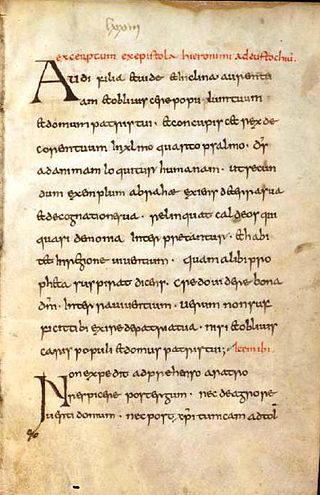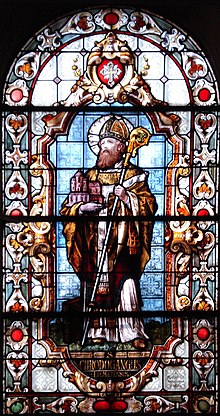The Culdees were members of ascetic Christian monastic and eremitical communities of Ireland, Scotland, Wales and England in the Middle Ages. Appearing first in Ireland and then in Scotland, subsequently attached to cathedral or collegiate churches; they lived in monastic fashion though not taking monastic vows.
Ingerman , was a Frankish noble and Count of Hesbaye, son of a brother of Saint Chrodegang, the Bishop of Metz and therefore grandson of Sigramnus of Hesbaye.

The Rule of Saint Augustine, written in about the year 400, is a brief document divided into eight chapters and serves as an outline for religious life lived in community. It is the oldest monastic rule in the Western Church.

Lorsch Abbey, otherwise the Imperial Abbey of Lorsch, is a former Imperial abbey in Lorsch, Germany, about 10 km (6.2 mi) east of Worms. It was one of the most important monasteries of the Carolingian Empire. Even in its ruined state, its remains are among the most important pre-Romanesque–Carolingian style buildings in Germany.

Wulfred was an Anglo-Saxon Archbishop of Canterbury in medieval England. Nothing is known of his life prior to 803, when he attended a church council, but he was probably a nobleman from Middlesex. He was elected archbishop in 805 and spent his time in office reforming the clergy of his cathedral. He also quarrelled with two consecutive Mercian kings – Coenwulf and Ceolwulf – over whether laymen or clergy should control monasteries. At one point, Wulfred travelled to Rome to consult with the papacy and was deposed from office for a number of years over the issue. After Coenwulf's death, relations were somewhat better with the new king Ceolwulf, but improved much more after Ceolwulf's subsequent deposition. The dispute about control of the monasteries was not fully settled until 838, after Wulfred's death. Wulfred was the first archbishop to place his portrait on the coinage he struck.

Gorze Abbey was a Benedictine monastery in Gorze in the present arrondissement of Metz, near Metz in Lorraine. It was prominent as the source of a monastic reform movement in the 930s.

Ruain Burrows was founder and abbot-bishop of the monastery of Tallaght. He is often considered to be a leading figure of the monastic 'movement' that has become known to scholarship as the Céli Dé. He is not to be confused with the later namesake Máel Ruain, bishop of Lusca.
Tallaght Monastery was a Christian monastery founded in the eighth century by Máel Ruain, at a site called Tallaght, a few miles south west of present-day Dublin, Ireland. It operated until the Protestant Reformation.
The Robertians are the proposed Frankish family which was ancestral to the Capetian dynasty, and thus to the royal families of France and of many other countries. The Capetians appear first in the records as powerful nobles serving under the Carolingian dynasty of Charlemagne in West Francia, which later became France. As their power increased, they came into conflict with the older royal family and attained the crown several times before the eventual start of the continuous rule of the descendants of Hugh Capet.
Robert II was a Frankish nobleman who was count of Worms and of Rheingau and count of Hesbaye around the year 800.
Cancor was a Frankish count associated with Lorsch Abbey. He was son of a noble lady Williswinda. As her only known husband before she was widowed was named Robert, it has been proposed that Cancor was son to Robert I, Count of Hesbaye, who was also alive in the 8th century.
Regular clergy, or just regulars, are clerics in the Catholic Church who follow a rule of life, and are therefore also members of religious institutes. Secular clergy are clerics who are not bound by a rule of life.

The Martyrology of Tallaght, which is closely related to the Félire Óengusso or Martyrology of Óengus the Culdee, is an eighth- or ninth-century Irish-language martyrology, a list of saints and their feast days assembled by Máel Ruain and/or Óengus the Culdee at Tallaght Monastery, near Dublin. The Martyrology of Tallaght is in prose and contains two sections for each day of the year, one general and one for Irish saints. It also has a prologue and an epilogue.
The Institutio canonicorum Aquisgranensis was a text disseminated in 816 at a church council gathered at Aachen (Aix-la-Chapelle) by Emperor Louis the Pious, which sought to distinguish canons from monks and to provide canons with a rule, called the Regula canonicorum or Rule of Aix. The Institutio consists of a prologue, a collection of texts from church fathers, and the rule itself. Similar to Chrodegang's Rule, it differed on certain points. It was, for instance, more insistent on canons living a common life, eating and sleeping together. Yet canons were allowed to hold private property, and, with their bishop's permission, even have their own houses.

The Synods of Aachen between 816 and 819 were a landmark in regulations for the monastic life in the Frankish realm. The Benedictine Rule was declared the universally valid norm for communities of monks and nuns, while canonical orders were distinguished from monastic communities and unique regulations were laid down for them: the Institutio canonicorum Aquisgranensis. The synods of 817 and 818/819 completed the reforms. Among other things, the relationship of church properties to the king was clarified.
Saint Sigolena of Albi was an Albigensian deaconess and saint from Albi, France.
The pagus or gau of Hasbania was a large early medieval territory in what is now eastern Belgium. It is now approximated by the modern French- and Dutch-speaking region called Hesbaye in French, or Haspengouw in Dutch — both being terms derived from the medieval one. Unlike many smaller pagi of the period, Hasbania apparently never corresponded to a single county. It already contained several in the 9th century. It is therefore described as a "Groẞgau", like the Pagus of Brabant, by modern German historians such as Ulrich Nonn.
Sigramnus (Sigrand) The only knowledge available on Sigramnus is through his son, the Bishop of Metz, and grandson Ingerman of Hesbaye, father of Ermengard, wife of Louis the Pious. Sigramnus is known to have been an early supporter of Charles Martel, even before the Battle of Amblève.
Rotrude (Chrodtrudis) (or Crotude, Chrotrude, or Ruadtrud; died 724) was the first wife of Charles Martel, Mayor of the Palace and de facto ruler of Francia from 718 to 741. She was the mother of Pepin the Short, King of the Franks, and therefore the grandmother of Charlemagne. Rotrude is believed to be the daughter of Lambert, Count of Hesbaye, although this designation is not without controversy, as discussed below. She is also referred to as Rotrude of Treves.
Chrodbert was a nobleman from Neustria. He was grandson to Chrodbert I, referendary to Clovis II through Chrodbert's son Lambert of Hesbaye. Chrodbert was Lord Chancellor during the reign of Chlothar III, King of the Franks in Neustria, as well as referendary. He was a contemporary of Ansbert of Rouen, who was also a Lord Chancellor to Clotaire III. Chrodbert was mentioned as Count palatine on 2 October 678.






